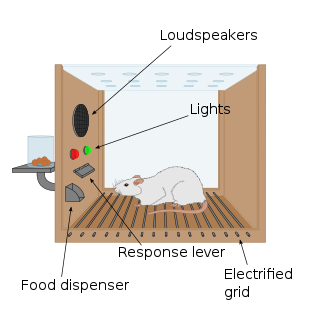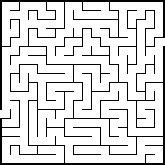Observational learning is learning that occurs through observing the behavior of others. It is a form of social learning which takes various forms, based on various processes. In humans, this form of learning seems to not need reinforcement to occur, but instead, requires a social model such as a parent, sibling, friend, or teacher with surroundings. Particularly in childhood, a model is someone of authority or higher status in an environment. In animals, observational learning is often based on classical conditioning, in which an instinctive behavior is elicited by observing the behavior of another, but other processes may be involved as well.
Operant conditioning, also called instrumental conditioning, is a learning process where voluntary behaviors are modified by association with the addition of reward or aversive stimuli. The frequency or duration of the behavior may increase through reinforcement or decrease through punishment or extinction.

An operant conditioning chamber is a laboratory apparatus used to study animal behavior. The operant conditioning chamber was created by B. F. Skinner while he was a graduate student at Harvard University. The chamber can be used to study both operant conditioning and classical conditioning.
Classical conditioning is a behavioral procedure in which a biologically potent stimulus is paired with a neutral stimulus. The term classical conditioning refers to the process of an automatic, conditioned response that is paired with a specific stimulus.

In behavioral psychology, reinforcement refers to consequences that increases the likelihood of an organism's future behavior, typically in the presence of a particular antecedent stimulus. For example, a rat can be trained to push a lever to receive food whenever a light is turned on. In this example, the light is the antecedent stimulus, the lever pushing is the operant behavior, and the food is the reinforcer. Likewise, a student that receives attention and praise when answering a teacher's question will be more likely to answer future questions in class. The teacher's question is the antecedent, the student's response is the behavior, and the praise and attention are the reinforcements.

Animal cognition encompasses the mental capacities of non-human animals including insect cognition. The study of animal conditioning and learning used in this field was developed from comparative psychology. It has also been strongly influenced by research in ethology, behavioral ecology, and evolutionary psychology; the alternative name cognitive ethology is sometimes used. Many behaviors associated with the term animal intelligence are also subsumed within animal cognition.

Edward Chace Tolman was an American psychologist and a professor of psychology at the University of California, Berkeley. Through Tolman's theories and works, he founded what is now a branch of psychology known as purposive behaviorism. Tolman also promoted the concept known as latent learning first coined by Blodgett (1929). A Review of General Psychology survey, published in 2002, ranked Tolman as the 45th most cited psychologist of the 20th century.
Behaviorism is a systematic approach to understand the behavior of humans and other animals. It assumes that behavior is either a reflex evoked by the pairing of certain antecedent stimuli in the environment, or a consequence of that individual's history, including especially reinforcement and punishment contingencies, together with the individual's current motivational state and controlling stimuli. Although behaviorists generally accept the important role of heredity in determining behavior, they focus primarily on environmental events. The cognitive revolution of the late 20th century largely replaced behaviorism as an explanatory theory with cognitive psychology, which unlike behaviorism examines internal mental states.
Motivational salience is a cognitive process and a form of attention that motivates or propels an individual's behavior towards or away from a particular object, perceived event or outcome. Motivational salience regulates the intensity of behaviors that facilitate the attainment of a particular goal, the amount of time and energy that an individual is willing to expend to attain a particular goal, and the amount of risk that an individual is willing to accept while working to attain a particular goal.

Clark Leonard Hull was an American psychologist who sought to explain learning and motivation by scientific laws of behavior. Hull is known for his debates with Edward C. Tolman. He is also known for his work in drive theory.
Extinction is a behavioral phenomenon observed in both operantly conditioned and classically conditioned behavior, which manifests itself by fading of non-reinforced conditioned response over time. When operant behavior that has been previously reinforced no longer produces reinforcing consequences the behavior gradually stops occurring. In classical conditioning, when a conditioned stimulus is presented alone, so that it no longer predicts the coming of the unconditioned stimulus, conditioned responding gradually stops. For example, after Pavlov's dog was conditioned to salivate at the sound of a metronome, it eventually stopped salivating to the metronome after the metronome had been sounded repeatedly but no food came. Many anxiety disorders such as post traumatic stress disorder are believed to reflect, at least in part, a failure to extinguish conditioned fear.
Latent inhibition (LI) is a technical term in classical conditioning, where a familiar stimulus takes longer to acquire meaning than a new stimulus. The term originated with Lubow and Moore in 1973. The LI effect is latent in that it is not exhibited in the stimulus pre-exposure phase, but rather in the subsequent test phase. "Inhibition", here, simply connotes that the effect is expressed in terms of relatively poor learning. The LI effect is extremely robust, appearing in both invertebrate and mammalian species that have been tested and across many different learning paradigms, thereby suggesting some adaptive advantages, such as protecting the organism from associating irrelevant stimuli with other, more important, events.

The reward system is a group of neural structures responsible for incentive salience, associative learning, and positively-valenced emotions, particularly ones involving pleasure as a core component. Reward is the attractive and motivational property of a stimulus that induces appetitive behavior, also known as approach behavior, and consummatory behavior. A rewarding stimulus has been described as "any stimulus, object, event, activity, or situation that has the potential to make us approach and consume it is by definition a reward". In operant conditioning, rewarding stimuli function as positive reinforcers; however, the converse statement also holds true: positive reinforcers are rewarding.
Discrimination learning is defined in psychology as the ability to respond differently to different stimuli. This type of learning is used in studies regarding operant and classical conditioning. Operant conditioning involves the modification of a behavior by means of reinforcement or punishment. In this way, a discriminative stimulus will act as an indicator to when a behavior will persist and when it will not. Classical conditioning involves learning through association when two stimuli are paired together repeatedly. This conditioning demonstrates discrimination through specific micro-instances of reinforcement and non-reinforcement. This phenomenon is considered to be more advanced than learning styles such as generalization and yet simultaneously acts as a basic unit to learning as a whole. The complex and fundamental nature of discrimination learning allows for psychologists and researchers to perform more in-depth research that supports psychological advancements. Research on the basic principles underlying this learning style has their roots in neuropsychology sub-processes.
Purposive behaviorism is a branch of psychology that was introduced by Edward Tolman. It combines the study of behavior while also considering the purpose or goal of behavior. Tolman thought that learning developed from knowledge about the environment and how the organism relates to its environment. Tolman's goal was to identify the complex cognitive mechanisms and purposes that guided behavior. His theories on learning went against the traditionally accepted stimulus-response connections at his time that had been proposed by other psychologists such as Edward Thorndike. Tolman disagreed with John B.Watson's behaviorism, so he initiated his own behaviorism, which became known as purposive behaviorism.
External inhibition is the observed decrease of the response of a conditioned reaction when an external (distracting) stimulus that was not part of the original conditioned response set is introduced. This effect was first observed in Ivan Pavlov's classical conditioning studies where the dogs would salivate less when presented with the sound of the tuning fork in the distracting context of a passing truck. External inhibition is important for its main principle in classical conditioning where a conditioned response may decrease in magnitude after the external stimulus is introduced. This is especially advantageous for when trying to disassociate conditioned stimulus and responses. A practical example is where students who become anxious upon standing in front of the class to give a presentation may feel less anxiety if their friends were sitting in front of the student presenting. The positive association of speaking to friends may distract the student from associating speaking to the entire class with anxiety.
An antecedent is a stimulus that cues an organism to perform a learned behavior. When an organism perceives an antecedent stimulus, it behaves in a way that maximizes reinforcing consequences and minimizes punishing consequences. This might be part of complex, interpersonal communication.
Social learning refers to learning that is facilitated by observation of, or interaction with, another animal or its products. Social learning has been observed in a variety of animal taxa, such as insects, fish, birds, reptiles, amphibians and mammals.
Pavlovian-instrumental transfer (PIT) is a psychological phenomenon that occurs when a conditioned stimulus that has been associated with rewarding or aversive stimuli via classical conditioning alters motivational salience and operant behavior. Two distinct forms of Pavlovian-instrumental transfer have been identified in humans and other animals – specific PIT and general PIT – with unique neural substrates mediating each type. In relation to rewarding stimuli, specific PIT occurs when a CS is associated with a specific rewarding stimulus through classical conditioning and subsequent exposure to the CS enhances an operant response that is directed toward the same reward with which it was paired. General PIT occurs when a CS is paired with one reward and it enhances an operant response that is directed toward a different rewarding stimulus.
Association in psychology refers to a mental connection between concepts, events, or mental states that usually stems from specific experiences. Associations are seen throughout several schools of thought in psychology including behaviorism, associationism, psychoanalysis, social psychology, and structuralism. The idea stems from Plato and Aristotle, especially with regard to the succession of memories, and it was carried on by philosophers such as John Locke, David Hume, David Hartley, and James Mill. It finds its place in modern psychology in such areas as memory, learning, and the study of neural pathways.





